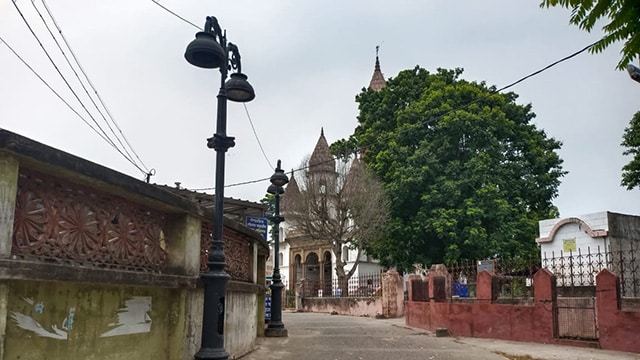For most parts of the year, Shibpur – a few kilometres from West Bengal’s state secretariat Nabanna – has little to offer of interest to most visitors. Once a bustling town with a lot of industries, Shibpur is now reduced to a predominantly non-Bengali town, where industries are languishing. Jute mills that employed locals have closed down to give way to high-rises, mainly inhabited by the neo-rich Marwari and Gujarati populations.
A botanical garden and a historic engineering college are its biggest highlight. Except on one day. The town has been rising to infamy for the last few years, thanks to communal violence breaking out here during the Ram Navami celebrations. Last Thursday, March 30th, Shibpur again became the subject of prime-time debates, thanks to a riot during a Ram Navami procession.
A quintessential north-Indian Hindu festival imported to the state a few years back, Ram Navami’s contentious celebrations are alien to the culture and traditions of West Bengal. In the past few years, many such incidents in the past have been recorded in the state.
But if this has become an annual affair, why isn’t the administration prepared or able to avert the crisis? To answer this crucial question, one must understand the demography and politics of Shibpur.

Prominent actor-playwright Jayraj Bhattacharya, involved in social movements in the region, has been a resident of Shibpur for several years. He narrates the story of a town divided along class and caste lines, the neo-rich Hindus and minority working-class Muslims.
“The area between Foreshore Road and GT Road is home to the majority of working-class Muslims. All of them are jute mill workers. The jute mills have closed down and high-rise flats have come up. These flats are mainly inhabited by the neo-rich, the Marwaris and the Gujaratis, who heavily fund the Hindutva groups,” he said.
Bhattacharya alleges that for the last three years, these groups have organised Ram Navami processions, raising provocative slogans as they pass from the minority areas.
“The tradition of Ram Navami in Howrah is very old; it is centred on Ramrajatala. It has nothing to do with this aggressive Ram from Uttar Pradesh. It is a very new phenomenon that is being nourished; where we feel that the government or the administration is not playing an efficient role,” he added.
Bhattacharya raises a pertinent question. “When the same thing happened in the last two years, how can it happen again, if the administration was careful?” he questioned.

In Shibpur, where country-made bombs were hurled during Thursday’s violence, locals also wanted to know why the police weren’t prepared. Especially after Chief Minister Mamata Bandopadhyay had warned her arch-rival Bharatiya Janata Party (BJP) of dire consequences should it resort to communal violence targeting the Muslims on the occasion of Ram Navami.
To understand why this violence couldn’t be averted, this correspondent who visited Shibpur on the day of violence, March 30th, tried to meet the local police station’s officer-in-charge Arup Kumar Roy; but he wasn’t in his office and neither did he answer calls.
As the administration is yet to give a convincing explanation for the lapse in security, the locals who suffered losses in Thursday’s rampage, are bearing the brunt of it.


Haider Ali (52) sells vegetables at the gate of Howrah Jute Mill in Shibpur. He recalled how the police did not allow him to set his handcart on the road on Thursday. Instead, he was told to set his shop inside the lane, as a Ram Navami procession would pass through this Muslim-majority area.
He followed their advice and yet the rioting mob didn’t spare his wares – cucumbers and lemons and even burnt his weighing scale – his most expensive investment.

As this correspondent walked along the lanes on Thursday night, the vestige of violence was visible from the police station to Fazir Bazar, along the GT Road. Burnt bikes, shops, rickshaws, handcarts, scattered chopped fruits, vegetables, watermelons, etc, were strewn on both sides of the road.
A group of young men standing near a lane leading to a temple stopped the correspondent on seeing him photograph signs of violence. When introduced, one of them said, what’s the use of taking pictures? “We have all the pictures and videos”.
Quite unapologetic about being a part of the mob which went rampage, Madhav Rao (36), who runs a garage said, “Everything was fine till 4pm. When the procession came, it was time for them (minority Muslims) to call for Azaan… We were silent for five minutes for the Azaan. Once the Azaan was over when we raised our ‘Jai Shri Ram’ slogans. That’s when I saw big stones and bottles being hurled from the rooftops of the neighbouring houses near the mosque close to Shri Jain Hospital,” he said.

Claiming that they started it first, Rao said. “If they charge at us, won’t we retaliate? Do we wear bangles? If they charge four, we’ll charge eight.”
Sexagenarian Mohammad Tahir owns the Royal Bengal Biryani shop near Fazir Bazar Auto Stand, was injured while moving the vessels of food, in the melee that broke out. Most Muslims refused to speak of what transpired out of fear.
“Don’t ask me anything. Ask the police, they were standing; everything happened in front of them,” said a youth standing in front of the biryani shop.

By 11pm on Thursday, as this correspondent exited Shibpur, the municipal workers with bulldozers and trucks had arrived to clear the streets of the debris – to restore normalcy. The fire which almost every TV channel had flashed images of had been extinguished but in Shibpur, a flame was still simmering beneath the surface.
Managing Editor of East Post Bangla. A geopolitical and socio-economic analyst and columnist. He writes extensively on global affairs and promotes the idea of a multi-polar world order.



